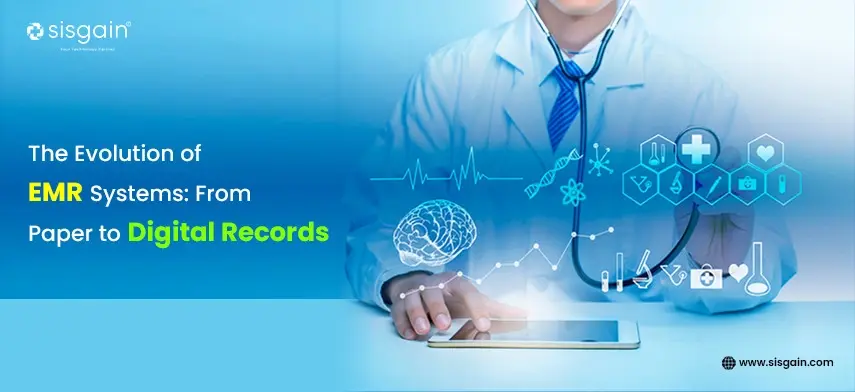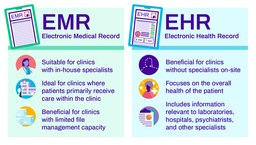Sales Team
Project quotes, partnerships, implementation

The days are gone when our medical records were stored in paper files. Today, EMR software has become prevalent in almost all medical institutions. Doctors in large hospitals and small clinics make use of medical electronic record systems to store medical information about their patients. EHR software and EMR software have become an indispensable part of medical services and are helping medical professionals easily manage patient records.
In the US, the percentage of office-based physicians using any EMR/EHR system is 88.2%. But do you know how these electronic health care systems came into being? How did paper records transition to digital records? If you are also curious about the evolution of electronic health record systems, then this blog is for you.
Here, we are going to discuss EMR and EHR software, their history, and why we have moved from physical records to digital records. Let’s get going.
EMR software, or Electronic Medical Record software, is a digital system used by healthcare providers to manage patient medical records. In simple words, a medical electronic record system is the digital version of paper medical records.
People often think that EMR and EHR software are the same. But they are not. An electronic health record system offers more comprehensive patient medical records as it stores information from multiple sources. On the other hand, EMR software stores patient data that is limited to one organization.

Medical electronic record systems help doctors save time and money. Doctors no longer need to look for patient records among a heap of other files. This not only consumes a lot of time but can also lead to delayed services. With electronic health record systems, patient records can be stored in the cloud for easy access.
The EMR software ensures the security of patient records. With everything digital, patient data can be encrypted with access to only chosen ones. This ensures that sensitive information is only accessible to people with permission, and no third party can pry into it.
Electronic health care systems have eliminated the need for paper records. Doctors no longer need to scribble everything with pens and pencils. Patient information can easily be stored in EHR software. This helps save money for papers, and their storage and reduces carbon footprint and deforestation.
Medical electronic record systems increase efficiency as repetitive tasks like data entry and documentation can be automated. This frees up time for more important tasks, and doctors can devote more of their time to their patients.
Digital records provide valuable data that can be analyzed to gain insights into patient’s health. Data analysis helps doctors form a plan of action and foresee any future complications. Electronic health record systems have enabled doctors to make data-driven decisions.
Since digital patient records can be shared with other departments, it fosters seamless communication between them. Different departments can access electronic health records and work in collaboration to provide accurate care.
Although the popularity and adoption of EMRs and EHRs are increasing, there are still some challenges that need to be addressed. Let's look at some challenges to implementing electronic health records:
The cost of buying and installing EMR software can be high for smaller organizations. Additionally, healthcare practitioners must be trained to use these systems, which can add to the overall costs.
Some doctors and nurses may find it cumbersome to switch from paper records to digital records. Patients can also worry about their data and privacy.
EHR software that is poorly built can make it difficult for doctors and nurses to operate them. They may find it frustrating to use them, which only leads to more resistance on their part.
EHRs being digital are prone to hacking, leading to a breach of sensitive patient data. Therefore, organizations must use EMR software that complies with the privacy of patient data.
The next challenge that arises in the adoption of medical electronic record systems is a lack of technical expertise. Doctors and nurses may find EHR software difficult to use and may be reluctant to replace it with paper records.
Get The Right Electronic Health Care Systems For Your Practice
If you want to streamline your medical practices, it's best that you get EMR software. Paper records are a thing of the past. Now its time to add digitalism to your practice and serve your patients better. Connect with our EMR/EHR software development company and let us provide you with a fully customised system. Connect with SISGAIN, and let us help you take your medical practice to new heights. Book a consultation with our team today, and let us discuss what we can do to streamline your healthcare services.
Electronic health records have come a long way. No doubt it has improved clinical decision making, inter-departmental collaboration, and the security of patient data. But there is still a long way to go. There are still many challenges that need to be overcome for EMR software to fully integrate with existing healthcare systems. Nevertheless, as we are fast moving with technological developments, the day is not far when electronic health records will dominate the healthcare industry and provide easy access to patient records.
Project quotes, partnerships, implementation
Open roles, referrals, campus hiring